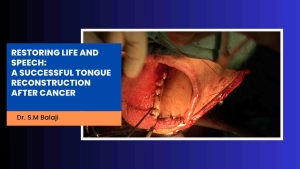Patient with progressive development of left lower facial deformity
The patient is a 17-year-old female from Mathura in Uttar Pradesh, India. She had been fine up until four years ago enjoying perfectly good health. It was around that time that a slight asymmetry began to develop in her left lower face.
This slowly began manifesting as sagging tissue in that region. It progressively worsened and her appearance became altered. Her family stated that she began to lock herself up in her room and refused to come outside.
This caused a great deal of distress for her parents. They took her to a neighbouring state for consultation with a doctor. She underwent testing, which revealed her to have plexiform neurofibroma. The condition was discussed in detail with her family members and they were advised surgical correction. Surgery was subsequently performed on her neurofibroma.
The patient and her parents were not happy with the results of the surgery. This caused the patient to become depressed about her situation. Her parents too were dismayed at the results of the surgery. This made them conduct enquiries regarding the best hospital for surgical correction of this condition. They were informed that our hospital was the best in cosmetic facial surgery in India.
Types of neurofibroma and their manifestations
Neurofibromatosis is the condition where there is tumorous growth in the nervous system. This can be differentiated into three types, namely neurofibromatosis type I, neurofibromatosis type II and schwannomatosis.
The first variant manifests as light brown spots on the skin. There are also freckles in the armpit and groin, small bumps within the nerves and scoliosis. Type 2 involves hearing loss, cataracts at a young age, balance problems, flesh-colored skin flaps and muscle wasting. The tumors generally do not change into cancerous tumours.
Plexiform neurofibromas are larger, more extensive tumors that grow from nerves anywhere in the body. Unlike cutaneous neurofibromas, plexiform neurofibromas are often found in young children. They can even be present at the time of birth.
The cause is a genetic mutation that occurs in certain genes. These can be inherited from a person’s parents or can occur spontaneously during early development. These tumors involve supporting cells in the nervous system rather than the neurons.
There is no known prevention or cure. Surgical removal is the only remedy for these tumors when they begin causing problems or become cancerous. Tumor suppressants are not effective in treating this condition. Reconstructive surgery offers adequate cosmetic results for these patients.
Initial presentation at our hospital for neurofibromatosis treatment
Dr SM Balaji, neurofibroma correction specialist, examined the patient and obtained a detailed oral history. He then ordered 3D CT scan and other radiological studies for the patient. Clinical examination revealed that her left lower face was sagging downwards. There were Café au Lait spots all over her body. The left ear lobule was also involved by the growth.
Presurgical counseling was provided to the patient and her parents. It was explained that the excess tissue had to be surgically excised through a submandibular approach. Extreme care would be taken while planning surgery to ensure that there was no facial disfigurement caused by the surgery.
Successful correction of facial disfigurement following surgery
Under general anesthesia, an incision was made in the submandibular region overlying the growth. Excess neurofibromatous tissue was excised and the incision was closed with sutures.
Outcome of the surgery:
The patient and her family were very happy with the outcome of the surgery. They expressed their thankfulness before final discharge from the hospital.





